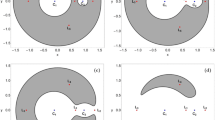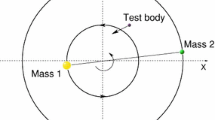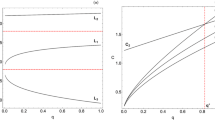Abstract
The case of the planar circular restricted three-body problem where one of the two primaries has a stronger gravitational field with respect to the classical Newtonian field is investigated. We consider the case where two primaries have the same mass, so as the the only difference between them to be the strength of the gravitational field which is controlled by the power p of the potential. A thorough numerical analysis takes place in several types of two dimensional planes in which we classify initial conditions of orbits into three main categories: (1) bounded, (2) escaping and (3) collision. Our results reveal that the power of the gravitational potential has a huge impact on the nature of orbits. Interpreting the collision motion as leaking in the phase space we related our results to both chaotic scattering and the theory of leaking Hamiltonian systems. We successfully located the escape as well as the collision basins and we managed to correlate them with the corresponding escape and collision time of the orbits. We hope our contribution to be useful for a further understanding of the escape and collision properties of motion in this interesting version of the restricted three-body problem.


















Similar content being viewed by others
Notes
In the “Appendix” we shall demonstrate that Keplerian circular orbits are also possible in the case where we have gravity stronger than the classical Newtonian one.
The most safe and efficient way to determine if an orbit escapes or not is the value of the total orbital energy of the particle measured by an observer in the inertial frame of reference. In particular, if the total orbital energy in the inertial frame is negative, the test particle might return back to the scattering region. On the contrary, if the total orbital energy becomes positive the test particle escapes, beyond any doubt, and it will never come back [6]. Our previous numerical experience (e.g., [53–55]) strongly suggests that the total orbital energy of the test-particle in the inertial frame becomes positive much sooner than it takes for the massless particle to cross the disk with radius \(R_d = 10\). Thus we may claim that our escape criterion used in the previous series of papers, and also in the present one, is both correct and safe. In the following Section we will present numerical evidence proving the validity of our escape criterion.
We choose the \({\dot{\phi }} < 0\) instead of the \({\dot{\phi }} > 0\) part simply because in [53] we seen that it contains more interesting orbital content.
When we state that an area is fractal we simply mean that it has a fractal-like geometry without conducting any specific calculations as in [2].
An infinite number of regions of (stable) quasi-periodic (or small scale chaotic) motion is expected from classical chaos theory.
References
Aguirre J, Vallego JC, Sanjuán MAF (2001) Wada basins and chaotic invariant sets in the Hénon–Heiles system. Phys Rev E 64:066208-1–066208-11
Aguirre J, Viana RL, Sanjuán MAF (2009) Fractal structures in nonlinear dynamics. Rev Mod Phys 81:333–386
Barrio R, Blesa F, Serrano S (2006) Is there chaos in Copenhagen problem? Monografías de la Real Academia de Ciencias de Zaragoza 30:43–50
Barrio R, Blesa F, Serrano S (2008) Fractal structures in the Hénon–Heiles Hamiltonian. Europhys Lett 82:10003
Barrio R, Blesa F, Serrano S (2009) Bifurcations and safe regions in open Hamiltonians. New J Phys 11:053004-1–053004-12
Benet L, Trautman D, Seligman T (1996) Chaotic scattering in the restricted three-body problem. I. The Copenhagen problem. Celest Mech Dyn Astron 66:203–228
Benet L, Seligman T, Trautman D (1998) Chaotic scattering in the restricted three-body problem II. Small mass parameters. Celest Mech Dyn Astron 71:167–189
Bleher S, Grebogi C, Ott E, Brown R (1998) Fractal boundaries for exit in Hamiltonian dynamics. Phys Rev A 38:930–938
Bleher S, Ott E, Grebogi C (1989) Routes to chaotic scattering. Phys Rev Lett 63:919–922
Bleher S, Grebogi C, Ott E (1990) Bifurcation to chaotic scattering. Phys D 46:87–121
Broucke RA (1968) Periodic orbits in the restricted three-body problem with Earth–Moon masses. Technical Report 32-1168, Jet Propulsion Laboratory, California Institute of Technology
Churchill R, Pecelli G, Rod DL (1975) Isolated unstable periodic orbits. J Differ Equ 17:329–348
Contopoulos G (1990) Asymptotic curves and escapes in Hamiltonian systems. Astron Astrophys 231:41–55
Contopoulos G (2002) Order and chaos in dynamical astronomy. Springer, Berlin
Contopoulos G, Kaufmann D (1992) Types of escapes in a simple Hamiltonian system. Astron Astrophys 253:379–388
Contopoulos G, Kandrup HE, Kaufmann D (1993) Fractal properties of escape from a two-dimensional potential. Phys D 64:310–323
de Moura APS, Grebogi C (2002) Countable and uncountable boundaries in chaotic scattering. Phys Rev E 66:046214
de Moura APS, Letelier PS (1999) Fractal basins in Hénon–Heiles and other polynomial potentials. Phys Lett A 256:362–368
de Assis SC, Terra MO (2014) Escape dynamics and fractal basin boundaries in the planar Earth–Moon system. Celest Mech Dyn Astron 120:105–130
Eckhardt B (1988) Irregular scattering. Phys D 33:89–98
Hénon M (1969) Numerical exploration of the restricted problem. V. Astron Astrophys 1:223–238
Jiménez-Lara L, Piña E (2003) The three-body problem with an inverse square law potential. J Math Phys 44:4078
Jung C, Scholz H (1988) Cantor set structures in the singularities of classical potential scattering. J Phys A 21:3607–3617
Kandrup HE, Siopis C, Contopoulos G, Dvorak R (1999) Diffusion and scaling in escapes from two-degrees-of-freedom Hamiltonian systems. Chaos 9:381–392
Kennedy J, Yorke JA (1991) Basins of Wada. Phys D 51:213–225
Lai Y-C, Tél T (2011) Transient chaos. Springer, New York
Milgrom M (1983) A modification of the Newtonian dynamics as a possible alternative to the hidden mass hypothesis. Astrophys J 270:365370
Motter AE, Lai YC (2002) Dissipative chaotic scattering. Phys Rev E 65:R0152051-1–R0152051-4
Nagler J (2004) Crash test for the Copenhagen problem. Phys Rev E 69:066218
Nagler J (2005) Crash test for the restricted three-body problem. Phys Rev E 71:026227
Navarro JF, Henrard J (2001) Spiral windows for escaping stars. Astron Astrophys 369:1112–1121
Ott E, Tél T (1993) Chaotic scattering: an introduction. Chaos 3:417–426
Petit J-M, Hénon M (1986) Satellite encounters. Icarus 66:536–555
Poon L, Campos J, Ott E, Grebogi C (1996) Wada basins boundaries in chaotic scattering. Int J Bifurc Chaos 6:251–266
Press HP, Teukolsky SA, Vetterling WT, Flannery BP (1992) Numerical recipes in FORTRAN 77, 2nd edn. Cambridge University Press, Cambridge
Sanjuán MAF, Horita T, Aihara K (2003) Opening a closed Hamiltonian map. Chaos 13:17–24
Schneider J, Tél T, Neufeld Z (2002) Dynamics of “leaking” Hamiltonian systems. Phys Rev E 66:066218
Schneider J, Tél T (2003) Extracting flow structures from tracer data. Ocean Dyn 53:64–72
Seoane JM, Aguirre J, Sanjuán MAF, Lai YC (2006) Basin topology in dissipative chaotic scattering. Chaos 16:023101-1–8
Seoane JM, Sanjuán MAF, Lai YC (2007) Fractal dimension in dissipative chaotic scattering. Phys Rev E 76:016208-1–016208-6
Seoane JM, Sanjuán MAF (2008) Exponential decay and scaling laws in noisy chaotic scattering. Phys Lett A 372:110–116
Seoane JM, Huang L, Sanjuán MAF, Lai YC (2009) Effects of noise on chaotic scattering. Phys Rev E 79:047202-1–047202-4
Seoane JM, Sanjuán MAF (2010) Escaping dynamics in the presence of dissipation and noisy in scattering systems. Int J Bifurc Chaos 9:2783–2793
Simó C, Stuchi T (2000) Central stable/unstable manifolds and the destruction of KAM tori in the planar Hill problem. Phys D 140:1–32
Siopis CV, Contopoulos G, Kandrup HE (1995) Escape probabilities in a Hamiltonian with two channels of escape. N Y Acad Sci Ann 751:205–212
Siopis CV, Kandrup HE, Contopoulos G, Dvorak R (1995) Universal properties of escape. N Y Acad Sci Ann 773:221–230
Siopis CV, Kandrup HE, Contopoulos G, Dvorak R (1996) Universal properties of escape in dynamical systems. Celest Mech Dyn Astron 65:57–681
Szebehely V (1967) Theory of orbits. Academic Press, New York
Tuval I, Schneider J, Piro O, Tél T (2004) Opening up fractal structures of three-dimensional flows via leaking. Europhys Lett 65:633–639
Wolfram S (2003) The mathematica book. Wolfram Media, Champaign
Zotos EE (2014) A Hamiltonian system of three degrees of freedom with eight channels of escape: the great escape. Nonlinear Dyn 76:1301–1326
Zotos EE (2014) Escapes in Hamiltonian systems with multiple exit channels: part I. Nonlinear Dyn 78:1389–1420
Zotos EE (2015) Crash test for the Copenhagen problem with oblateness. Celest Mech Dyn Astron 122:75–99
Zotos EE (2015) How does the oblateness coefficient influence the nature of orbits in the restricted three-body problem? Astrophys Space Sci 358:10
Zotos EE (2015) Unveiling the influence of the radiation pressure in nature of orbits in the photogravitational restricted three-body problem. Astrophys Space Sci 360:1
Zotos EE (2015) Escapes in Hamiltonian systems with multiple exit channels: part II. Nonlinear Dyn 82:357–398
Zotos EE (2015) Orbital dynamics in the planar Saturn–Titan system. Astrophys Space Sci 358:4
Zotos EE (2015) Orbit classification in the planar circular Pluto–Charon system. Astrophys Space Sci 360:7
Zotos EE (2015) Classifying orbits in the restricted three-body problem. Nonlinear Dyn 82:1233–1250
Zotos EE (2016) Escape dynamics and fractal basins boundaries in the three-dimensional Earth–Moon system. Astrophys Space Sci 361:94
Acknowledgments
I would like to express my warmest thanks to the two referees for the careful reading of the manuscript and for all the apt suggestions and comments which allowed us to improve both the quality and the clarity of the paper.
Author information
Authors and Affiliations
Corresponding author
Ethics declarations
Conflict of interest
The author declares that he has no conflict of interest.
Appendix: Existence and stability of circular orbits in the generalized Kepler problem
Appendix: Existence and stability of circular orbits in the generalized Kepler problem
It is well known that in the classical Newtonian gravitational potential \(V = - k/r^n\), where \(n = 1\), a circular orbit always exists. When \(n \ne 1\) we have the case of the generalized Kepler problem. According to theoretical mechanics a necessary condition for the existence of circular orbits is the central potential to be attractive. In the following we shall demonstrate for which values of n we stable or unstable circular solutions.
The total effective potential \(V_{\mathrm{eff}}\) in a central force field is the sum of the central potential \(V_C\) and the centrifugal term \(V_L\).
where \(n > 0\), \(k > 0\), and \(m > 0\). In Fig. 19 we present a plot of \(V_{\mathrm{eff}}\), \(V_C\), and \(V_L\) when \(k = m = L = 1\) and \(n =3/2\).
Evolution of \(V_{\mathrm{eff}}\) (black), \(V_C\) (blue), and \(V_L\) (green) as a function of radius r, when \(k = m = L = 1\), and \(n = 3/2\). The vertical and the horizontal magenta dashed lines indicate the radius \(r_0\) and the corresponding energy \(E_0\) of the circular orbit, respectively. (Color figure online)
The radius \(r_0\) of the circular orbit, if exists, is obtained by setting the first derivative of the total effective potential equal to zero. Therefore we have
For \(n = 3/2\) we derive that \(r_0 = \frac{4L^2}{9m^2k^2}\). Looking at Eq. (9) it becomes evident that circular solutions are indeed permissible for every value of n except for \(n = 2\).
The energy of the circular orbit, \(E_0\), can easily be found if we insert the expression (9) of \(r_0\) into Eq. (8). After applying elementary calculations we obtain
The last term of Eq. (10), that is \(\left( 1 - \frac{n}{2}\right) \), suggests that when \(0< n <2\) \(E_0\) is negative, while for \(n > 2\) \(E_0\) is positive. In other words, for \(0< n <2\) the equilibrium point of \(V_{\mathrm{eff}}\) at \(r_0\) is a global minimum, while for \(n > 2\) it is a global maximum. Here it should be noticed that the sign of the energy at the equilibrium point already implies the stability of the circular orbits.
Our next task is to determine for which values of n the corresponding circular orbit is stable and for which becomes unstable. It is very easy to prove that in a central force field the necessary and also sufficient condition for a circular orbit with radius \(r_0\) to be stable is the following
where of course
and
Evolution of S as a function of the power n of the gravitational central potential \(V_C\), when \(k = m = L = 1\). The horizontal blue dashed line denotes the threshold \(S = 0\), which distinguishes between stable and unstable circular orbits. Stable circular orbits exist only in the interval \(n \in (0,2)\), while for \(n > 2\) circular orbits are permissible however they are all unstable. (Color figure online)
Inserting Eqs. (9), (12), and (13) into (11) we obtain S as a function of n as follows
In Fig. 20 we illustrate the evolution of S(n), when \(k = m = L = 1\). It is seen, that in the interval \(n \in (0,2)\) \(S > 0\) and therefore stable circular orbits exist. On the other hand, for \(n > 2\) circular orbits do exist however they are unstable since \(S < 0\). In this paper we investigate the nature of orbits in the planar circular restricted three-body problem where one of the primaries has a strong gravitational field. We consider only cases where n varies in the interval (1, 2), where according to Eq. (14) stable Keplerian orbits are indeed permissible.
Rights and permissions
About this article
Cite this article
Zotos, E.E. Investigating the planar circular restricted three-body problem with strong gravitational field. Meccanica 52, 1995–2021 (2017). https://doi.org/10.1007/s11012-016-0548-2
Received:
Accepted:
Published:
Issue Date:
DOI: https://doi.org/10.1007/s11012-016-0548-2






